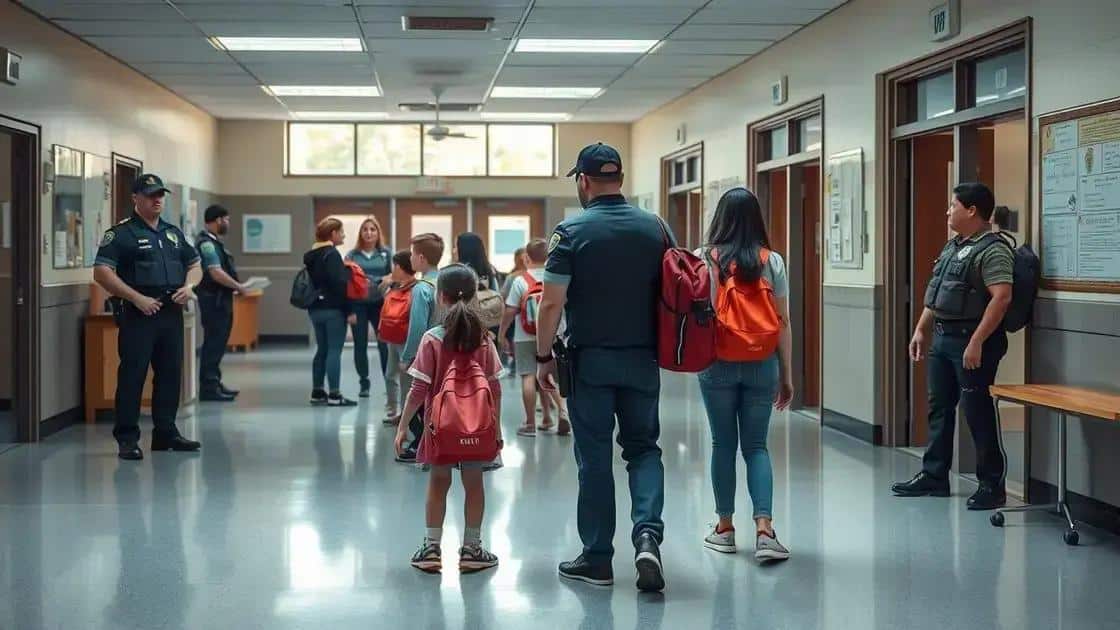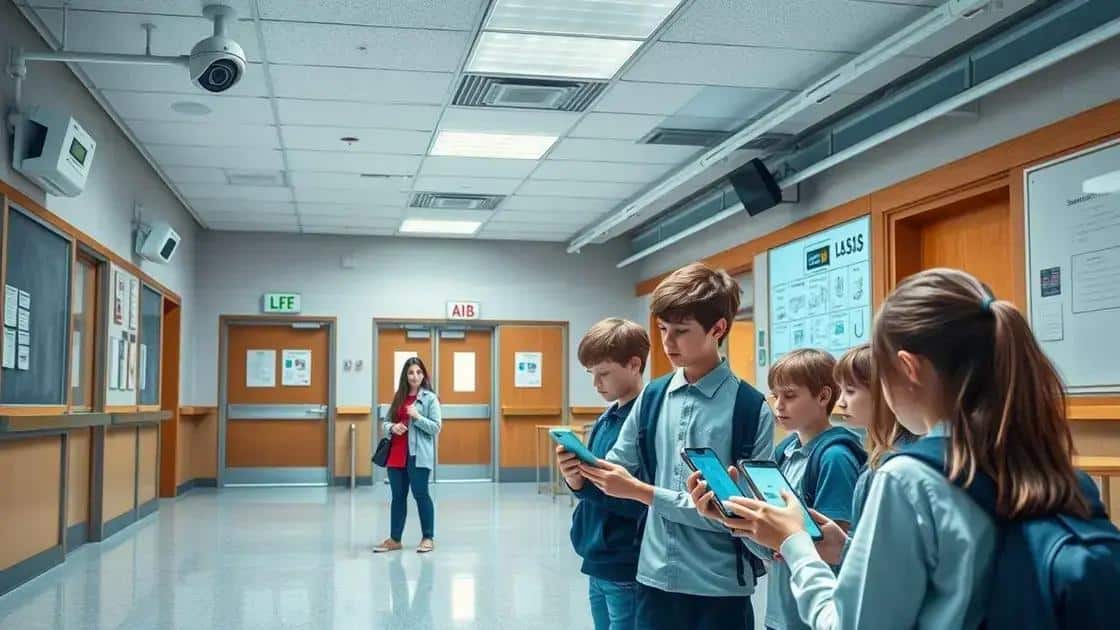More school safety initiative: enhancing student protection

The more school safety initiative focuses on engaging community involvement, utilizing technology, and continuous evaluation of safety programs to ensure a secure learning environment for students.
The more school safety initiative aims to create a secure learning environment for students across the nation. As schools face new challenges, this initiative introduces innovative strategies that prioritize student safety and well-being. Let’s explore the key components of this important movement.
Understanding the need for enhanced school safety
Understanding the need for enhanced school safety is crucial for creating secure learning environments. Schools are meant to be safe havens for students, but recent events have highlighted vulnerabilities in safety measures. By acknowledging the risks, we can work together to implement better strategies.
Identifying key risks in schools
Many factors contribute to the need for improved safety. From bullying to external threats, understanding these risks is the first step toward better protections. Schools must recognize that safety is multifaceted and requires continuous evaluation.
- Bullying and emotional distress among students
- Physical threats from intruders
- Lack of emergency preparedness
- Inadequate mental health support
As we delve deeper, it’s important to realize that each school has unique challenges that may impact its safety strategy. Administering a thorough assessment of these risks helps in identifying specific areas that need immediate attention. Implementing educational programs taught by professionals can foster a culture of awareness and responsibility among students and staff.
Community impact on school safety
The role of the community in school safety cannot be overstated. Engaging parents and local organizations creates a robust support system that prioritizes student well-being. Parents, educators, and law enforcement working together can significantly enhance security measures.
Regular meetings and workshops can inform everyone involved about best practices in school safety. Open lines of communication ensure that everyone feels heard and valued. Before implementing new changes, schools should actively seek feedback from families to determine what is most needed. This collaborative approach also builds trust within the community.
Overall, understanding the need for enhanced school safety requires a commitment to ongoing improvement and collaboration. By addressing risks and fostering community involvement, schools can work towards creating a better, safer environment for all students.
Innovative measures for crime prevention in schools
Innovative measures for crime prevention in schools play a vital role in enhancing the safety of students and staff. By implementing modern techniques, schools can create a more secure environment that fosters learning and development. It is important for schools to stay ahead of potential threats by utilizing advanced strategies.
Utilizing technology for enhanced security
Technology has become an essential tool in creating safer school environments. From surveillance cameras to smart security systems, schools can monitor their premises effectively. These technologies allow for real-time response to any unusual activity, ensuring prompt action is taken when needed.
- Installing surveillance cameras at key locations
- Integrating access control systems for restricted areas
- Using emergency alert systems for immediate communication
- Implementing anonymous reporting tools for students
Employing technology not only acts as a deterrent but also provides valuable data that can inform security policies. Understanding patterns of behavior through technology can help in devising targeted interventions. Additionally, educating students about the importance of reporting suspicious activities empowers them to take part in their own safety.
Creating a positive school culture
Another innovative approach is to promote a positive school culture. When students feel safe and respected, they are less likely to engage in harmful behaviors. Schools should focus on fostering relationships and encouraging communication among students, teachers, and staff.
Programs that enhance social-emotional learning can reduce instances of bullying and violence. When students learn how to manage their emotions and interact positively with others, they contribute to a safer school environment. Programs such as conflict resolution training can be highly effective. By teaching students how to resolve disagreements peacefully, schools can create a more harmonious atmosphere.
Ultimately, the combination of modern technology and a supportive school culture works hand in hand to promote crime prevention in schools. Engaging all members of the school community in these initiatives is crucial for their success. The ongoing assessment and adaptation of these measures ensure they remain effective and relevant in an ever-changing world.
Role of technology in school safety initiatives

The role of technology in school safety initiatives has become increasingly important in recent years. Schools are now adopting various tech solutions to ensure a safer learning environment. By using modern technology, schools can enhance security measures and address potential threats more effectively.
Innovative tech solutions for school safety
There are several innovative tools and platforms that schools can implement. These solutions range from surveillance systems to communication apps, each designed to protect students and staff.
- Video surveillance systems help monitor school premises.
- Access control systems manage entry to sensitive areas.
- Emergency communication apps allow instant alerts.
- Digital reporting tools enable students to report concerns anonymously.
These technologies provide crucial support during emergencies. For instance, schools can quickly notify authorities about potential dangers. This fast response can be the difference between safety and disaster.
Data analysis and risk assessment
Another significant aspect of technology in school safety is data analysis. Schools can collect and analyze information to identify patterns and assess risks. By understanding trends in behavior, schools can create targeted safety measures.
Additionally, technology enables schools to conduct drills and simulations more effectively. By using virtual scenarios, students can practice emergency procedures in a safe environment. This preparedness helps build confidence and ensures everyone knows how to respond in case of an actual emergency.
Ultimately, the integration of technology in school safety initiatives strengthens the overall security framework. With continuous advancements in technology, schools must remain proactive to adapt to new challenges and threats that may arise in the future.
Community involvement in school safety strategies
Community involvement in school safety strategies is essential for creating a secure and supportive environment for students. When parents, local organizations, and law enforcement work together, they can strengthen the safety measures within schools. By fostering collaboration, schools can ensure everyone is invested in the well-being of students.
Engaging parents and guardians
One of the first steps in increasing community involvement is engaging parents and guardians. Schools can organize meetings and workshops to discuss safety concerns and strategies. This open dialogue helps parents feel more connected and informed.
- Regular safety meetings encourage transparency.
- Workshops provide training on emergency responses.
- Surveys gather feedback from parents about safety issues.
- Involving parents in school safety committees increases commitment.
When parents know what is happening regarding school safety, they can contribute ideas and support initiatives. They can also help educate their children about safe practices, reinforcing what is taught at school.
Partnerships with local organizations
Forming partnerships with local organizations and businesses is another valuable approach. These partnerships can lead to resources and support for safety programs. Local businesses can sponsor safety drills or offer funding for security upgrades.
Additionally, collaborating with community organizations can bring in experts who provide training on various safety topics. This includes mental health awareness, conflict resolution, and emergency preparedness training.
By connecting with local law enforcement, schools can create a current and effective response plan for emergencies. Police officers can participate in school events, allowing students to build positive relationships with them. This trust can make students feel safer and more willing to report issues.
Community involvement leads to a comprehensive approach to school safety. When everyone comes together and contributes, schools can create safer environments where students can thrive. Engagement, open communication, and collaboration are vital for these strategies to succeed.
Evaluating the effectiveness of safety programs
Evaluating the effectiveness of safety programs is crucial for ensuring student security. Schools must assess how well their current programs are working and identify areas for improvement. Through systematic evaluation, schools can enhance their safety initiatives and provide a more secure environment.
Setting measurable goals
To evaluate safety programs effectively, it’s important to set clear, measurable goals. Schools should define what success looks like and create benchmarks to assess progress. This allows for better tracking and management of safety initiatives.
- Establish clear success criteria for each program.
- Gather data on incidents and responses.
- Conduct regular surveys to collect feedback from students and staff.
- Utilize performance metrics to gauge effectiveness.
By having specific targets, schools can measure their progress and make informed decisions about future safety strategies. Consistent evaluation promotes accountability and helps maintain focus on student safety.
Reviewing data and feedback
Another key aspect of evaluating safety programs is reviewing both quantitative and qualitative data. Schools should analyze incident reports to understand trends and patterns. Looking at factors such as the number of incidents over time can indicate whether safety measures are effective.
Moreover, gathering feedback from students, parents, and staff is invaluable. Surveys and focus groups can provide insights into the perceived safety of the school environment. This feedback helps schools understand areas of concern and the effectiveness of their programs.
Incorporating community input allows for a more comprehensive evaluation process. When everyone involved contributes to the conversation, schools can tailor their safety initiatives to better meet the needs of the community. Additionally, improvements arising from these evaluations can lead to safer and more effective schools for everyone involved.
FAQ – Frequently Asked Questions about School Safety Initiatives
Why is community involvement important for school safety?
Community involvement fosters collaboration among parents, local organizations, and schools, creating a supportive environment that enhances student safety.
How can technology improve school safety?
Technology improves school safety through surveillance systems, emergency communication tools, and data analytics, allowing for quick responses to incidents.
What are some effective strategies for evaluating safety programs?
Effective strategies include setting measurable goals, reviewing incident data, collecting feedback from the community, and making continuous improvements.
How can parents get involved in school safety initiatives?
Parents can participate by attending safety meetings, providing feedback through surveys, and joining school safety committees to help develop effective strategies.






